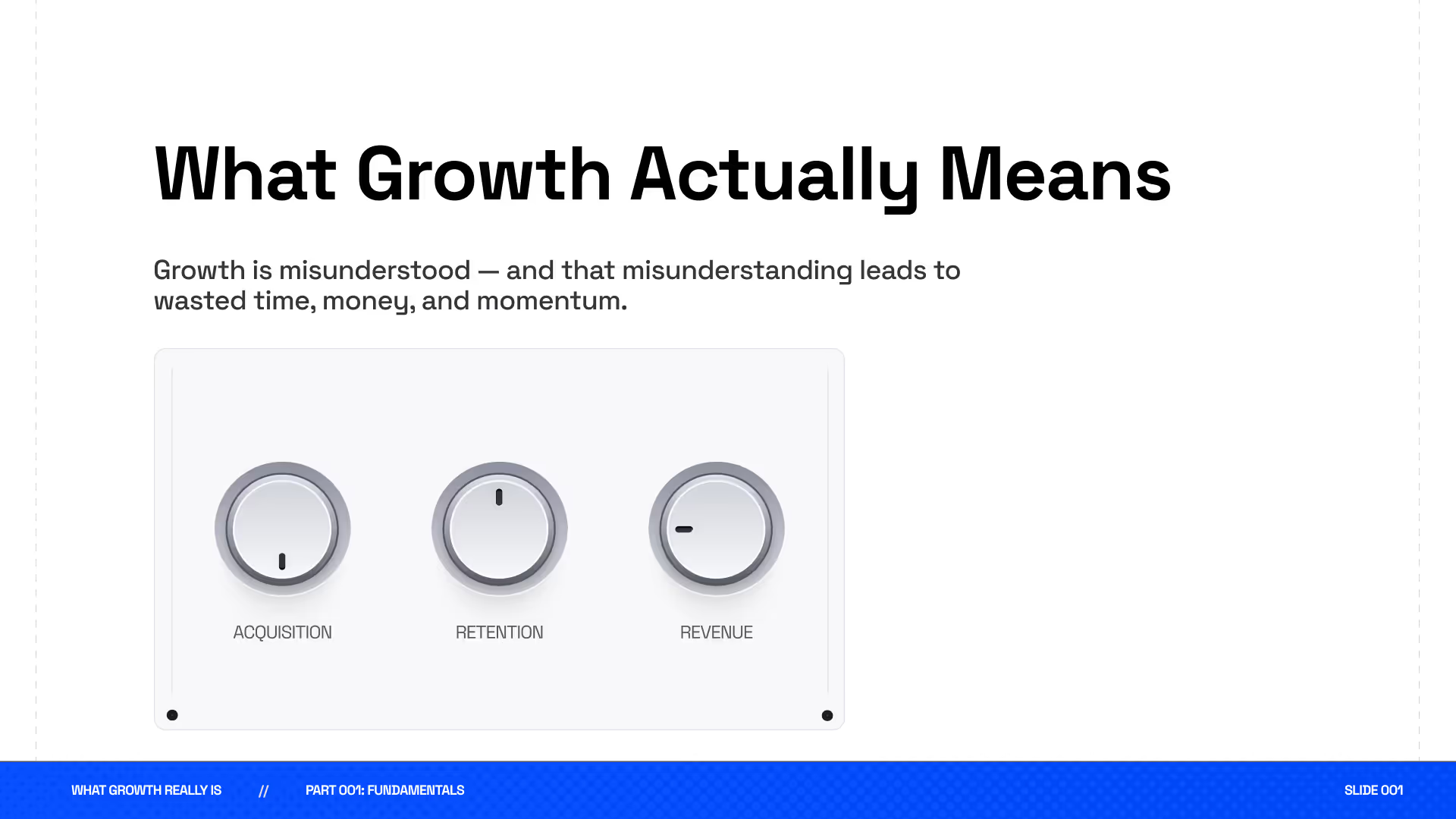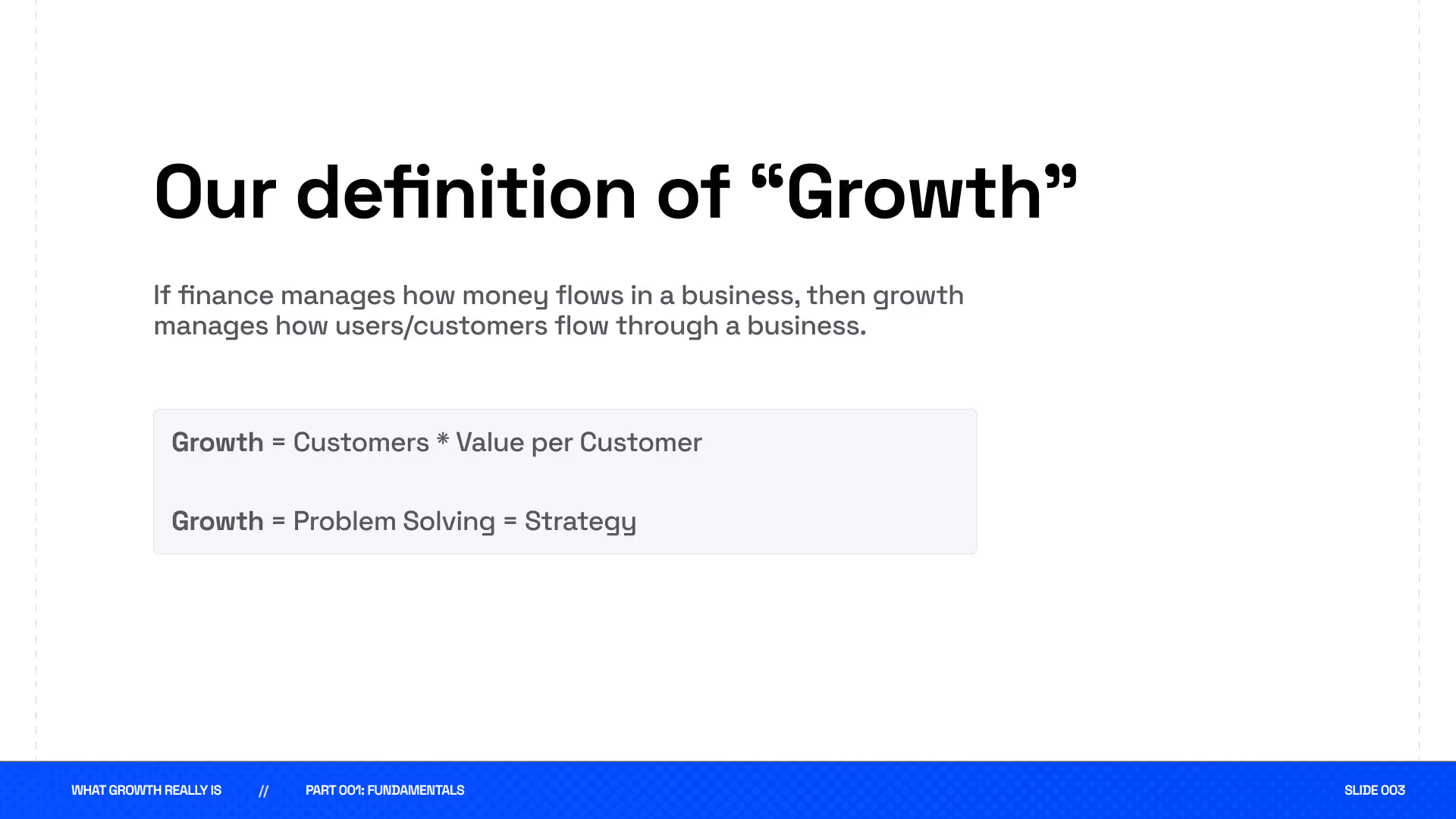
Conversation

🥳 Feedback Received!
Thanks for taking a moment to share your thoughts — it genuinely helps us make each chapter sharper.
What happens next:
- Your feedback goes straight to our product team.
- We’ll use it to refine lessons, clarify examples, and make the program even more useful.
Appreciate you helping make this program better for everyone.
Ready for your next challenge? 👇
Our definition of “growth”
Welcome to our lesson on what growth actually means. You've just overviewed our growth system and have a view of what you're about to not only learn, but build and achieve through the rest of the program.

However, before we can get into designing our growth engine and more broadly architecting our growth system as a whole, I want to take some time to explore and cover some really important concepts and misconceptions that will help you level up as a growth leader and operator, as well as give us a shared language and mental model throughout the program.
Overview - 7 Key Concepts
So let's get into it.
We're going to start with our definition of growth, and what we mean is how we at Demand Curve view and define growth, and how we teach growth in this program.
Why does this shared definition matter?
In short, growth can be misunderstood and quite nebulous. If you ask 10 different people to define growth, you're likely to get 10 different answers. And since we don't know your background coming into the program, establishing that shared definition gives us a blank slate to start and build from.
To be clear, we're not interested in setting this definition for the sake of saying what is or is not technically correct. We're not interested in trying to coin proprietary concepts. We simply want this shared language as it will help you as you move through the program.
The next key concept we will examine is how systems design is a core component of our philosophy and approach to growth. We'll take a look at how you'll need to grow like a scientist. We'll examine the more data and hypothesis-driven approach to growth that we teach. We'll then explain why focus is such a key concept for startups and growth operators as a whole.
From there, we’ll explore why you need to think like an artist. Our approach to growth is a balanced approach, valuing both the science and the art equally.
We'll make a case for why we believe founder-led growth is so critical in the early stages. And finally, we'll discuss how the AI era may (or may not) force us to rethink how startup growth should be approached.
Our Definition of Growth
So let’s start with our definition. What is growth?
There are a couple of different ways that I like to think about and teach when it comes to understanding what growth really is.
A simple one — and I don't remember when I was initially introduced to this, but it stuck with me early on — was someone saying that:
If a finance team is responsible for how money flows in a business, then growth is responsible for how our users and customers flow through a business.
And I think that's a really powerful analogy because right there it helps to clear up some really important misconceptions. It helps to very quickly explain what growth is not:
- Growth is not purely marketing.
- Growth is not A/B testing.
- Growth is not about chasing short-term “hacks.”

What it tells us is that growth is holistic. If growth is responsible for managing and owning how users flow through the entirety of our business, then we know that growth spans the entirety of our business functions, which is exactly what our Foundational Five framework in the previous lesson is meant to convey.
Another Simple Definition
There are a couple of other simple definitions that I like to come back to, as well.
Another is that growth's role is to maximize the number of people who experience our core product value. It's another way of framing the finance analogy. It tells us that growth is not purely customer acquisition.
Why? Because there are a number of ways to maximize how many people experience our core value.
Levers for Growth
Yes, acquiring more customers is a key lever, but we can also increase how many people experience core value by eliminating friction. We can decrease the number of people who do not make it all the way through our funnel and experience core product value.
We can remove friction from our funnel to basically open up that funnel, to remove the constraints and the friction that were previously limiting how many people would move through.
Beyond Acquisition
Additionally, we can work to ensure that more people actively use the product and experience its core value repeatedly. And many people might think that's the job of a product team, and it is, to some extent.
Product teams are largely focused on maximizing the core value of the product itself, and that’s obviously a huge driver of how many people will experience said core value. But that’s a very different focus than maximizing how many people experience that value.
So we also have purview across the product itself.
We can identify triggers and channels within and outside the product to make it easier for users to not only experience that initial value, but also to continually come back and get more of it.
Revenue as a Lever
On top of that, we can also maximize how many people experience core product value by optimizing our revenue model to ensure that we're maximizing the value in a monetary sense that we're capturing from our customers.
Because if we can do that, then we can afford to invest more in acquiring customers.
We can afford to invest more in improving the core value of the product.
We can invest more across our entire Foundational Five, bolstering our brand and story, which will also attract more customers, increase conversion rates, and enhance our average customer value.
The Bigger Picture
What we're seeing here is that growth as we define it and as we're going to teach it to you, especially at the startup stage, is that it really has no bounds. It spans across your entire foundation and your entire funnel and customer journey.
The Ultimate Goal
Now that being said, it's also worth taking a step back and remembering, very simply, what our ultimate goal is at the startup level.
Yes, we can think about it as maximizing how many people experience core value.
Why do we do that?
We do that because we believe core value is a proxy for our ultimate company objective, which is typically to produce as much revenue or profit as possible.
So at the end of the day, the role of growth is very simply to increase the number of customers that we have, and to increase the value per customer.
So to wrap up, you now have a pretty good sense of what growth is by our definition, which also informs what growth is not.
You are not learning just growth marketing. You will not only learn about ad channels. Growth is not just running A/B tests or funnel optimization.
All of these things are subsets of growth, and they are tools in our toolkit.
You're going to learn a far more expansive skill set.


